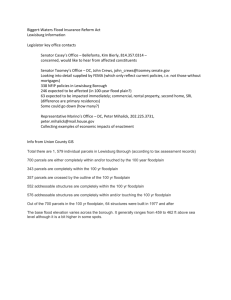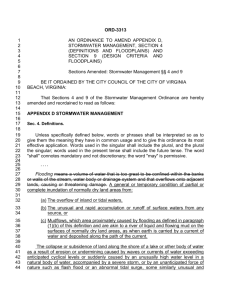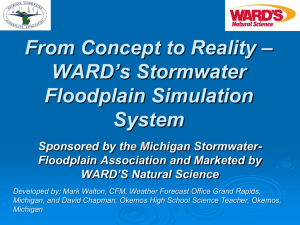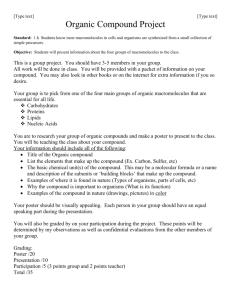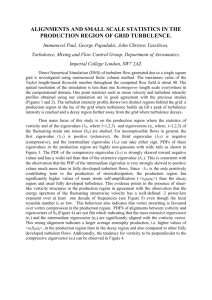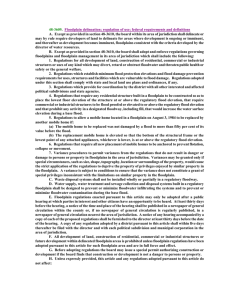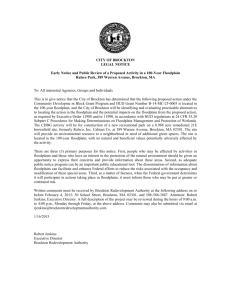Flow, Sediment, and Nutrient Transport in a Riparian Mangrove
advertisement
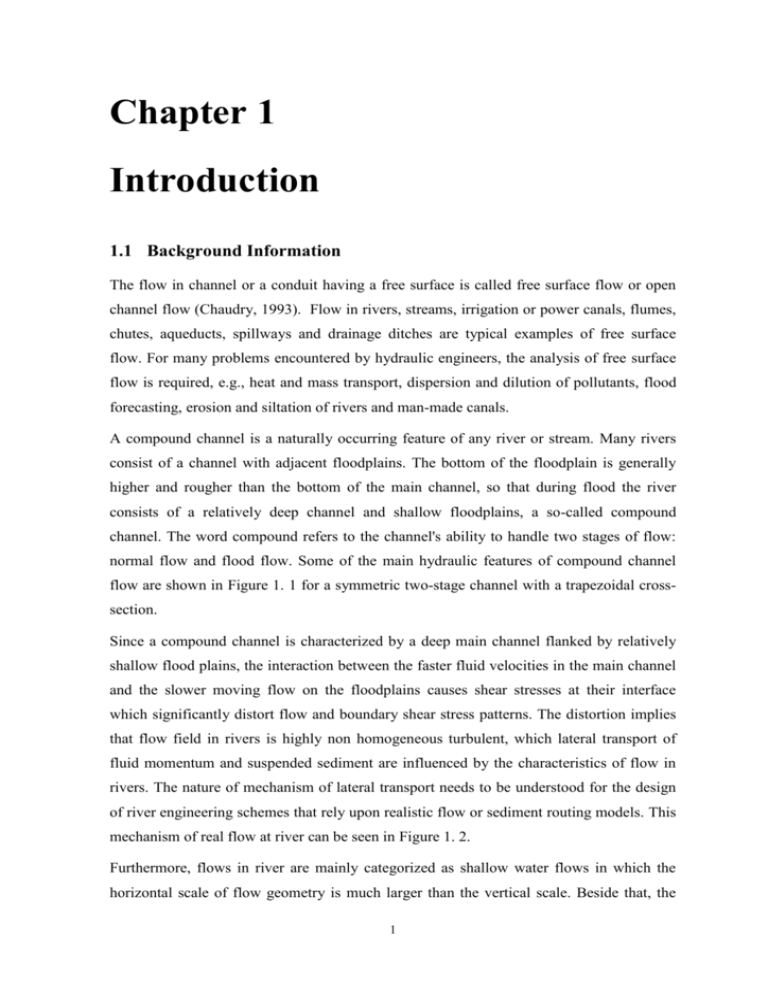
Chapter 1 Introduction 1.1 Background Information The flow in channel or a conduit having a free surface is called free surface flow or open channel flow (Chaudry, 1993). Flow in rivers, streams, irrigation or power canals, flumes, chutes, aqueducts, spillways and drainage ditches are typical examples of free surface flow. For many problems encountered by hydraulic engineers, the analysis of free surface flow is required, e.g., heat and mass transport, dispersion and dilution of pollutants, flood forecasting, erosion and siltation of rivers and man-made canals. A compound channel is a naturally occurring feature of any river or stream. Many rivers consist of a channel with adjacent floodplains. The bottom of the floodplain is generally higher and rougher than the bottom of the main channel, so that during flood the river consists of a relatively deep channel and shallow floodplains, a so-called compound channel. The word compound refers to the channel's ability to handle two stages of flow: normal flow and flood flow. Some of the main hydraulic features of compound channel flow are shown in Figure 1. 1 for a symmetric two-stage channel with a trapezoidal crosssection. Since a compound channel is characterized by a deep main channel flanked by relatively shallow flood plains, the interaction between the faster fluid velocities in the main channel and the slower moving flow on the floodplains causes shear stresses at their interface which significantly distort flow and boundary shear stress patterns. The distortion implies that flow field in rivers is highly non homogeneous turbulent, which lateral transport of fluid momentum and suspended sediment are influenced by the characteristics of flow in rivers. The nature of mechanism of lateral transport needs to be understood for the design of river engineering schemes that rely upon realistic flow or sediment routing models. This mechanism of real flow at river can be seen in Figure 1. 2. Furthermore, flows in river are mainly categorized as shallow water flows in which the horizontal scale of flow geometry is much larger than the vertical scale. Beside that, the 1 CHAPTER 1 INTRODUCTION flows in river are also almost turbulent. For example, Figure 1. 3 shows array of horizontal vortices observed at a flood at a straight reach of Tone River, Japan. This means that the fluid motion is highly random, unsteady, and three-dimensional. Due to these complexities, the flow can not be properly predicted by using approximate analytical solutions to the governing equations of motion. With the complexity of the problems, the solution of turbulent is simplified with mathematics equation. In spite of all the recent advances in computer technology, the storage capacity and the speed of present day computers is still not sufficient to compute the turbulent or in other words, it will perhaps never be possible to simulate true turbulence mathematically on computer. In order to circumvent this situation, turbulent fluctuations are approximated by a suitable averaging of the governing equations. These averaged equations describe the complete effect of turbulence on the average motion. This representation is usually referred to as turbulence modeling. Figure 1. 1 Hydraulic parameters associated with floodplain flow in a compound channel (Shiono, K. & Knight,D.W., [15]). 2 CHAPTER 1 INTRODUCTION Direction of flow Figure 1. 2 Vortices at the interface between the main channel and floodplain flow, Medicine Hat, Alberta (Tuitoek, D.K., [16]). Figure 1. 3 Horizontal vortices at the interface between the main channel and floodplain flow, Tone River, Japan (Courtesy of Ministry of Construction, 1981). 3 CHAPTER 1 INTRODUCTION In the recent 2 decades, many turbulence modeling has been developed. There are three main turbulence modeling for a turbulent flow based on Navier Stokes equations: the Reynolds Averaged Navier Stokes simulation (RANS), the Direct Numerical Simulation (DNS) and the Large Eddy Simulation (LES). Based on the LES method, the SDS-2DH model is employed to study the horizontal vortices 1.2 Objective The objectives of this research is applying LES SDS-2DH model to flow in compound channel to obtain basic comprehensive understanding of lateral transport mechanism (i.e. momentum transport). 1.3 Scope of the Research This research will conducted both turbulence modeling and experiment for compound channel. Laboratory experiment with rectangular geometry and smooth roughness is conducted to compare the numerical simulation which SDS 2DH model is employed in turbulence modeling. 4 CHAPTER 1 INTRODUCTION Chapter 1 ............................................................................................................................... 1 Introduction ........................................................................................................................... 1 1.1 Background Information........................................................................................ 1 1.2 Objective................................................................................................................ 4 1.3 Scope of the Research............................................................................................ 4 Figure 1. 1 Hydraulic parameters associated with floodplain flow in a compound channel (Shiono, K. & Knight,D.W., [15]). ...................................................................... 2 Figure 1. 2 Vortices at the interface between the main channel and floodplain flow, Medicine Hat, Alberta (Tuitoek, D.K., [16]). ......................................................... 3 Figure 1. 3 Horizontal vortices at the interface between the main channel and floodplain flow, Tone River, Japan (Courtesy of Ministry of Construction, 1981). ... 3 5

